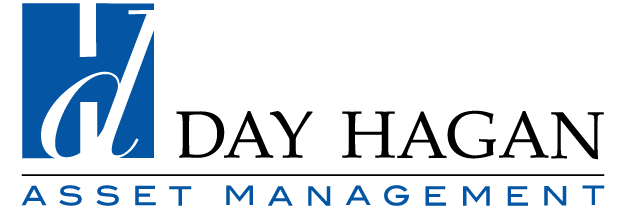Day Hagan Tech Talk: Helter-Skelter
A downloadable PDF copy of the Article: Day Hagan Tech Talk: Helter-Skelter (pdf)
Summary
Following one of the biggest short squeezes in recent memory (4.9.25) and within the confines of the S&P 500’s pattern of lower price peaks and lower price troughs, I expect upside and downside volatility to continue despite the recent tariff news. What are we now watching?
Chaos
The Beatles’ 1968 song Helter Skelter, featured on their “White Album,” is even more chaotic than the slide it references. Per Merriam-Webster, helter-skelter is “disorderly confusion: turmoil,” “undue haste,” and being “confusedly hurried,” a time when chaotic events happen rapidly.
It’s safe to say that the last several days have been helter-skelter. 3Fourteen Research recently penned, “The ‘Liberation Day’ tariff announcement sent the S&P 500 into one of the worst three-day tailspins ever. Then, yesterday (4.9.25), Trump relented and delayed the implementation of most tariffs. The market went on to rally by 9.4%, which tied March 24, 2020, for the third-highest single-day return in modern history.” On 4.10.25, SPX recorded an intraday decline of over 4%. On 4.11.25, the DJIA fell almost 340 intraday, yet was up over 800 later in the session. Capital Wealth Planning summarized it well: “The S&P 500 traded within a 650-point range from highs to lows… The rampant volatility was a result of the country’s tariff policy, which has been very fluid… The flurry of tariff activity has left investors nervous and on edge.” Ya think? Thus far this week, there has been volatility in both directions, but not to last week’s degree.
Signposts
In a downtrend, resistance is more important than support because it gives you a level(s) from which to act (de-risk) based on your tolerance for risk. Also, how markets react to resistance reflects the amount of overhanging selling pressure. S&P 500 (SPX) resistance (Figure 1): 5500 to 5571, 5700+/-. And in what might be a stretch, 5800+/-.
Stable or higher prices following additional negative tariff news (perceived or otherwise). This would imply that equities have found a level from which they have discounted the news.
Breadth Thrusts – a cluster of breadth thrusts: Advancing volume exceeded declining volume by a ratio of ten to one or greater and advancing issues and advancing volume was 90% or better, both on 4.9.25 (potential momentum thrust). Multiple extreme readings within a short period can help confirm upside momentum in the stock market.
Testing and retesting recent price low: Considering the amount of chart damage (overhanging selling pressure), much repair work is necessary—time and volatility. Note: A full retest of the 4.7-4.8 lows can be above or below those levels. Another possibility is a retest of support above those levels (Figure 1). The key is less selling pressure during any retest. More work is needed to complete a bottom because a “V” bottom (straight down and straight up) is a low-probability event.
Chart Damage = Chart Repair = Time and Volatility
Following the S&P 500’s successful test of critical support in the vicinity of 4800 (please see last week’s report), the index is approaching multiple layers of overhanging selling pressure (resistance).
Figure 1: S&P 500 with falling 21-day and 50-day MA. | Resistance in red, support in green.
Conditions Move, Charts Reflect – Take 2
Charts don’t move markets; conditions move markets.
Charts reflect (usually anticipate) the effects of changing conditions.
Treasury Secretary Bessent recently noted that the dollar is still a strong global reserve currency. The chart below of the U.S. Dollar Index, however, begs the question: is something rotten in the state of Denmark?
Figure 2: U.S. Dollar Index and Overbought/Oversold gauge. | What might be brewing under the surface, as the U.S. dollar and fixed income have been under pressure simultaneously?
Figure 3: MOVE Index. | A move above resistance would imply further volatility in the fixed income market, which may bleed over into equities due to increasing domestic political/policy/confidence risk. For now, a deeper pullback would be supportive.
The Day Hagan Smart Sector Strategies incorporate built-in risk management parameters relating to sector allocation and equity versus cash allocation. Please let me know if you would like to schedule a call to discuss the process and discipline underpinning our Smart Sector with Catastrophic Stop, Smart Sector International, and Smart Sector Fixed Income strategies. Disclosures and Fact Sheets can be found here: https://dhfunds.com/literature.
Day Hagan Asset Management appreciates being part of your business, either through our research efforts or investment strategies. Please let us know how we can further support you.
Art Huprich, CMT®
Chief Market Technician
Day Hagan Asset Management
—Written 4.14-15.25. Chart source: Stockcharts.com unless otherwise noted.
Disclosure
The data and analysis contained herein are provided “as is” and without warranty of any kind, either express or implied. Day Hagan Asset Management (DHAM), any of its affiliates or employees, or any third-party data provider, shall not have any liability for any loss sustained by anyone who has relied on the information contained in any Day Hagan Asset Management literature or marketing materials. All opinions expressed herein are subject to change without notice, and you should always obtain current information and perform due diligence before investing. DHAM accounts that DHAM, or its affiliated companies manage, or their respective shareholders, directors, officers and/or employees, may have long or short positions in the securities discussed herein and may purchase or sell such securities without notice. The securities mentioned in this document may not be eligible for sale in some states or countries, nor be suitable for all types of investors; their value and income they produce may fluctuate and/or be adversely affected by exchange rates, interest rates or other factors.
Investment advisory services offered through Donald L. Hagan, LLC, a SEC registered investment advisory firm. Accounts held at Raymond James and Associates, Inc. (member NYSE, SIPC) and Charles Schwab & Co., Inc. (member FINRA, SIPC). Day Hagan Asset Management is a dba of Donald L. Hagan, LLC.
